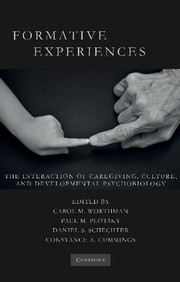Book contents
- Frontmatter
- Contents
- List of Figures
- List of Tables
- List of Contributors
- Foreword by Robert Sapolsky
- Preface
- List of Abbreviations
- Introduction
- SECTION ONE HISTORICAL, CROSS-CULTURAL, AND DEVELOPMENTAL SCIENCE PERSPECTIVES
- SECTION TWO HOW EXPERIENCE INTERACTS WITH BIOLOGICAL DEVELOPMENT
- SECTION THREE FORMATIVE RELATIONSHIPS WITHIN AND ACROSS GENERATIONS
- SECTION FOUR SOCIAL AND CULTURAL CONTEXTS OF CHILDHOOD DEVELOPMENT – NORMATIVE SETTINGS, PRACTICES, AND CONSEQUENCES
- SECTION FIVE FEAR, FUN, AND THE BOUNDARIES OF SOCIAL EXPERIENCE
- 15 Ethnographic Case Study: Anak PKI – A Longitudinal Case Study of the Effects of Social Ostracism, Political Violence, and Bullying on an Adolescent Javanese Boy
- Commentary
- Commentary
- 16 The Evolution of Social Play
- 17 Ethological Vignette: Social Stress as a Formative Experience – Neurobiology of Conditioned Defeat
- Commentary
- Commentary
- Commentary
- 18 The Basic Affective Circuits of Mammalian Brains: Implications for Healthy Human Development and the Cultural Landscapes of ADHD
- SECTION SIX PUBLIC HEALTH, EDUCATION, AND POLICY IMPLICATIONS
- Index
- References
Commentary
Published online by Cambridge University Press: 26 May 2010
- Frontmatter
- Contents
- List of Figures
- List of Tables
- List of Contributors
- Foreword by Robert Sapolsky
- Preface
- List of Abbreviations
- Introduction
- SECTION ONE HISTORICAL, CROSS-CULTURAL, AND DEVELOPMENTAL SCIENCE PERSPECTIVES
- SECTION TWO HOW EXPERIENCE INTERACTS WITH BIOLOGICAL DEVELOPMENT
- SECTION THREE FORMATIVE RELATIONSHIPS WITHIN AND ACROSS GENERATIONS
- SECTION FOUR SOCIAL AND CULTURAL CONTEXTS OF CHILDHOOD DEVELOPMENT – NORMATIVE SETTINGS, PRACTICES, AND CONSEQUENCES
- SECTION FIVE FEAR, FUN, AND THE BOUNDARIES OF SOCIAL EXPERIENCE
- 15 Ethnographic Case Study: Anak PKI – A Longitudinal Case Study of the Effects of Social Ostracism, Political Violence, and Bullying on an Adolescent Javanese Boy
- Commentary
- Commentary
- 16 The Evolution of Social Play
- 17 Ethological Vignette: Social Stress as a Formative Experience – Neurobiology of Conditioned Defeat
- Commentary
- Commentary
- Commentary
- 18 The Basic Affective Circuits of Mammalian Brains: Implications for Healthy Human Development and the Cultural Landscapes of ADHD
- SECTION SIX PUBLIC HEALTH, EDUCATION, AND POLICY IMPLICATIONS
- Index
- References
Summary
INTRODUCTION
The case of Joko, a Javanese boy who suffered from repeated traumas of interpersonal origins, illustrates the principles of developmental traumatology (De Bellis, 2001). Developmental traumatology is the systematic investigation of the neurobiological impact of chronic interpersonal violence on the developing child. It is a relatively new area of study that synthesizes knowledge from developmental psychopathology, developmental neuroscience, and stress and trauma research. In the emerging field of developmental traumatology, measures of trauma (type, age of onset, and duration of trauma), as well as other mediating factors such as social support, are regarded as independent variables. Behavioral, cognitive, emotional, and neurobiological measures are considered dependent variables (De Bellis et al., 1999).
Joko was interviewed while living at a Catholic orphanage, and following a horrific experience of being bullied, assaulted, all while witnessing the torture and public humiliation of his older brother, Paidjo. Joko was suffering from posttraumatic stress disorder (PTSD). He had significant symptoms of PTSD cluster B intrusions of the trauma; PTSD cluster C symptoms of dissociation, hopelessness, depression, and numbing; and PTSD cluster D symptoms of hyperarrousal (American Psychiatric Association, 2000, pp. 424–432).
Neurobiological sequelae of child maltreatment may be regarded as an environmentally induced complex developmental disorder, which may lead to an array of outcomes through these clusters of symptoms (De Bellis, 2001). During adolescence, the healthy development of prefrontal cortex leads to inhibitory pathways that quiet the brain's amygdala and biological stress systems, complex structures that register the emotional rage of injustice.
- Type
- Chapter
- Information
- Formative ExperiencesThe Interaction of Caregiving, Culture, and Developmental Psychobiology, pp. 390 - 397Publisher: Cambridge University PressPrint publication year: 2010



